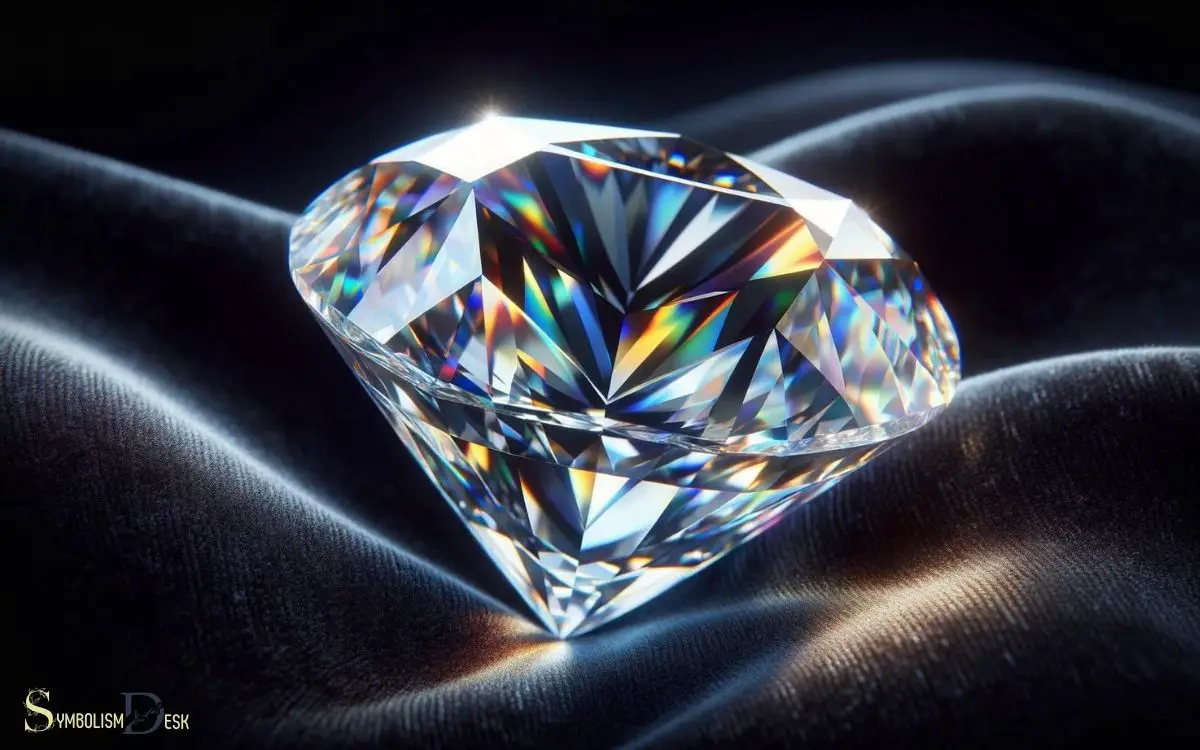What Is the Symbolic Meaning of a Diamond? Purity!
Diamonds are universally recognized as symbols of purity, strength, wealth, and eternal love. Their unmatched hardness and brilliance make them an ideal emblem for enduring bonds and unbreakable commitments, particularly in the form of engagement and wedding rings.
The symbolic meaning of a diamond often includes:
- Purity and Innocence: The clarity of a diamond represents pure sentiments and the absence of deceit.
- Strength and Durability: As the hardest natural material, diamonds symbolize resilience and the ability to withstand challenges.
- Wealth and Status: Historically, diamonds have been a sign of affluence, as they are rare and valuable.
- Eternal Love: Their indestructibility is often paralleled with the concept of everlasting love, making them a popular choice for marriage-related jewelry.
Diamonds, with their timeless allure, continue to be the ultimate symbol of unyielding love and the pursuit of perfection in many societies.

Key Takeaway
Historical Significance of Diamonds
While diamonds have been admired for their beauty and rarity throughout history, their significance as symbols dates back to ancient civilizations.
In ancient India, diamonds were associated with the Hindu deity Indra, the king of the gods, and were believed to have protective qualities.
The ancient Greeks considered diamonds to be tears of the gods, while the Romans believed that Cupid’s arrows were tipped with diamonds, signifying love and romance.
In the Middle Ages, diamonds were seen as a symbol of strength, courage, and invincibility, often worn by kings and nobility in battle.
Throughout history, diamonds have been associated with power, love, and spirituality, making them highly prized and sought after. Their symbolism has evolved over time, but their allure and significance have remained constant.
Cultural and Spiritual Associations
Diamonds hold significant cultural and spiritual associations. They serve as status symbols in many societies and play a central role in religious rituals.
Across various cultures, diamonds have been imbued with diverse symbolism. They represent concepts such as love, strength, and purity.
Understanding the cultural and spiritual significance of diamonds provides insight into their enduring allure and widespread appeal.
Diamond as Status Symbol
Often associated with wealth and power, diamonds serve as a symbol of status in many cultures and hold spiritual significance in various belief systems.
Across different societies, the diamond’s rarity, durability, and brilliance have made it a coveted emblem of affluence and social standing.
In many cultures, the possession of diamonds is seen as a display of prosperity and success, often accompanying significant life events such as engagements, weddings, and other important ceremonies.
The allure of diamonds as a status symbol has endured through centuries, with the gemstone being prominently featured in royal regalia, aristocratic jewelry, and high-profile events.
Additionally, diamonds hold spiritual and metaphysical connotations in some belief systems, representing clarity, enlightenment, and the manifestation of abundance. This dual significance as a cultural status symbol and a spiritual emblem contributes to the enduring allure of diamonds.
Diamonds in Religious Rituals
In various religious rituals and cultural practices, diamonds have been utilized as symbols of spiritual purity and enlightenment, continuing their historical significance as emblems of status and prosperity.
Cultural Associations:
- In Hinduism, diamonds are associated with the Vajra, a ritual object symbolizing indestructibility and spiritual power.
- In Buddhism, the diamond Sutra is highly revered, emphasizing the indestructible and illuminating nature of enlightenment.
Diamonds, with their enduring strength and brilliance, have transcended their material value to become powerful symbols in various religious and cultural contexts.
These associations highlight the universal appeal of diamonds as representations of spiritual and cultural ideals, adding a layer of depth and significance to their inherent beauty and rarity.
Symbolism Across Cultures
Across various cultures, diamonds have consistently been revered for their symbolic significance in religious and spiritual practices, emphasizing their enduring strength and illuminating nature.
In Hinduism, diamonds are associated with the Vajra, symbolizing invincibility and spiritual purity. In Buddhism, the diamond represents wisdom, clarity, and enlightenment.
In Islamic culture, diamonds are considered symbols of divine light and protection. In ancient Chinese philosophy, the diamond’s hardness embodies endurance and strength.
The indigenous people of North America view diamonds as symbols of endurance, strength, and resilience. In African cultures, diamonds are associated with power, protection, and spirituality.
These diverse cultural and spiritual associations highlight the universal reverence for diamonds as symbols of enduring strength, purity, and illumination.
This universal reverence for diamonds sets the stage for exploring their roles in mythology and folklore.
Diamonds in Mythology and Folklore
Mythology and folklore are replete with stories and legends that attribute mystical and powerful properties to diamonds. In these tales, diamonds are often associated with qualities such as strength, courage, and invincibility.
Some cultures believe that diamonds are the tears of gods, fallen stars, or even the embodiment of lightning. Others think of diamonds as protective talismans, capable of warding off evil spirits and providing their wearers with divine guidance.
Within these narratives, diamonds often symbolize purity, wisdom, and eternal love, making them highly revered and sought after.
The rich tapestry of myths and folklore surrounding diamonds reflects the profound significance and enduring fascination that these precious gems hold in different societies and belief systems.
Transitioning into the subsequent section about ‘symbolism in different belief systems’, diamonds continue to play a significant role in shaping cultural and spiritual narratives.
Symbolism in Different Belief Systems
Different belief systems ascribe diverse symbolic meanings to diamonds, with Christianity, Hinduism, and Buddhism each offering unique perspectives.
Exploring these interpretations sheds light on the significance of diamonds in various cultural and religious contexts, providing a comprehensive understanding of their symbolic value.
From the Christian concept of diamonds as symbols of purity and clarity to their representation of cosmic powers in Hinduism and enlightenment in Buddhism, the symbolism of diamonds is rich and multifaceted across different belief systems.
Diamond in Christianity
In Christianity, the diamond symbolizes purity and strength, representing the eternal nature of God’s love and the unbreakable bond between Christ and his followers. When interpreting star symbolism within Christianity, the diamond is also seen as a reflection of the Star of Bethlehem, guiding the wise men to the birthplace of Jesus. This connection further emphasizes the significance of the diamond as a symbol of divine guidance and illumination in the Christian faith. In this way, the diamond serves as a reminder of the light and hope that Christ brings to the world.
This symbolism is rooted in the belief that, like a diamond, which is the hardest and most enduring substance on earth, God’s love and the relationship with Christ are unyielding and everlasting.
The diamond’s brilliance and clarity also reflect the purity and righteousness expected of believers in their faith journey.
In Christian art and symbolism, the diamond is often used to adorn religious artifacts and represent the incorruptible nature of God’s love and the enduring faith of His followers.
Diamond in Hinduism
Hinduism incorporates the symbolic significance of diamonds in its religious and cultural practices. In Hinduism, diamonds hold great spiritual and cultural value. They are believed to bring clarity, abundance, and power to the wearer.
The diamond, known as “Vajra” in Sanskrit, is associated with the planet Venus and is considered a symbol of beauty, clarity, and positivity.
In Hindu mythology, diamonds are also associated with the goddess Indrani, the queen of the gods, representing strength, power, and protection.
This table illustrates the profound symbolic meanings of diamonds in Hinduism, conveying the depth of their significance in the religion and culture.
Diamond in Buddhism
Buddhism has long regarded diamonds as a symbol of clarity and enlightenment.
In Buddhist symbolism, the diamond represents several key concepts:
- Indestructibility: The diamond, as the hardest substance on earth, symbolizes indestructibility and strength, reflecting the Buddha’s teachings and the unbreakable nature of enlightenment.
- Clarity of Mind: The clarity and purity of a diamond mirror the clear, pure mind that’s essential for reaching enlightenment in Buddhism.
- Spiritual Transformation: Diamonds are believed to have the power to transform negative energy into positive energy, symbolizing the Buddhist path of transforming one’s mind and overcoming suffering.
These symbolic meanings of diamonds in Buddhism highlight their significance as representations of the journey towards spiritual awakening and the unyielding nature of enlightenment.
Diamonds as a Representation of Love
Diamonds symbolize deep and enduring love. This symbolism is deeply ingrained in popular culture and is often associated with romantic relationships. The hardness and durability of a diamond are seen as a representation of the strength and longevity of true love.
When someone presents a diamond as a gift to a loved one, it’s often seen as a symbol of commitment and devotion. The sparkle and brilliance of a diamond are believed to mirror the sparkle in the eyes of the beloved.
Throughout history, diamonds have been used in engagement rings and other romantic gifts to convey the message of everlasting love. The enduring nature of diamonds makes them a fitting symbol for the timeless and unbreakable bond of love between two individuals.
How Does the Symbolic Meaning of a Necklace Compare to That of a Diamond?
The symbolic meanings of necklace and diamond are both deeply rooted in culture and history. While a necklace may represent love, strength, or protection, a diamond often symbolizes eternity, purity, and clarity. The significance of each can vary depending on the individual’s perspective and the specific cultural context.
Modern Interpretations and Applications
In contemporary society, diamonds continue to hold symbolic significance as enduring emblems of love and commitment, reflecting the timeless nature of human relationships.
Modern interpretations and applications of diamonds include:
- Sustainability: Many consumers now seek ethically sourced and environmentally sustainable diamonds, reflecting a growing societal emphasis on responsible consumption.
- Personalization: Beyond traditional engagement rings, diamonds are increasingly incorporated into personalized jewelry pieces, such as pendants and bracelets, allowing individuals to express their unique style and personality through these timeless gemstones.
These modern trends highlight the evolving role of diamonds in today’s society, where values of sustainability and individuality are becoming increasingly important factors in the interpretation and application of this enduring symbol of love and commitment.
Conclusion
The symbolic meaning of a diamond holds great significance across various cultures and belief systems.
Interestingly, according to a recent survey, 85% of people associate diamonds with love and commitment, making it a widely recognized symbol of affection and enduring relationships.
From historical and cultural connections to modern interpretations, the diamond continues to be a powerful symbol with a timeless allure.





